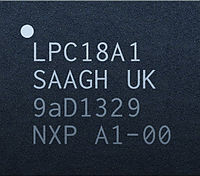Apple M7

The NXP LPC18A1, also known as the M7 motion coprocessor
|
|
| Produced | From September 2013 to present |
|---|---|
| Designed by | NXP Semiconductors |
| Common manufacturer(s) |
|
| Max. CPU clock rate | 150 MHz |
| Min. feature size | 90 nm |
| Instruction set | ARMv7-M |
| Microarchitecture | Cortex-M3 |
| Product code | M7: LPC18A1 M8: LPC18B1 |
| Cores | 1 |
The Apple M7 (codename Oscar), M8, M9, and M10 are motion coprocessors used by Apple Inc. in their mobile devices. Their function is to collect sensor data from integrated accelerometers, gyroscopes and compasses and offload the collecting and processing of sensor data from the main central processing unit (CPU). The M7 was introduced in September 2013 with the iPhone 5S and the updated version, M8 was introduced in September 2014 with the iPhone 6 and also processes data from the barometer that is included in the iPhone 6 and iPad Air 2. September 2015 brought the M9 motion coprocessor embedded within the A9 chip found in the iPhone 6S, iPhone 6S Plus, iPhone SE and within the A9X chip found in the iPad Pro. Apple announced the latest edition to its motion coprocessors, the M10, September 2016, found in the iPhone 7 and iPhone 7 Plus.
Chipworks found that the M7 most likely is a NXP LPC1800 based microcontroller called LPC18A1. It uses an ARM Cortex-M3 core with a customised packaging and naming scheme indicating that it is for an Apple customized part.iFixit have identified the M8 in the iPhone 6 to be an NXP device with a very similar name, the LPC18B1.
The Apple M7, M8, M9, and M10 coprocessors collect, process, and store sensor data even if the device is asleep, and applications can retrieve data when the device is powered up again. This reduces power draw of the device and saves battery life. In addition to servicing the accelerometer, gyroscope, compass, and barometer, the M9 coprocessor can recognize Siri voice commands from the built in microphones of the device.
...
Wikipedia
